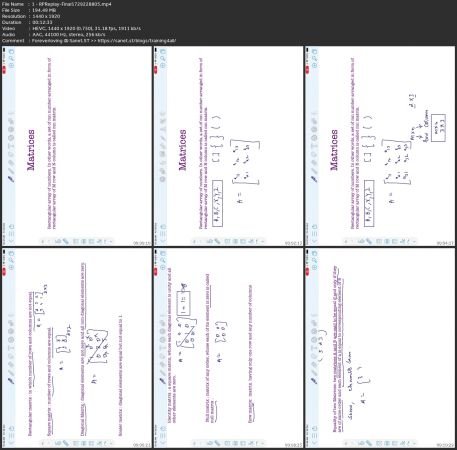- Thread Starter
- #1
Mathematical Micro Economics

What you'll learn
Solve consumer equilibrium problem mathematically
Solve the perfectly competitive price and output
Identify the returns to scale
Calculate the cost function
Requirements
Basic understanding of economics and mathematics
Description
he Mathematical Microeconomics course is designed to provide a rigorous, mathematics-focused approach to key topics in microeconomic theory. This course goes beyond conceptual overviews and delves into mathematical techniques to analyze and solve economic models, providing students with practical tools for understanding economic behavior and market dynamics quantitatively. Usually, students of economics face problems when it comes to solving the mathematical problems in micro economics.Key topics covered include Consumer Theory, where we explore utility maximization, demand functions, and income/price effects; Production Theory, examining cost functions, profit maximization, and production optimization; and Market Structure Analysis, focusing on competitive and monopoly markets, and extending into Oligopoly models using game theory to understand strategic interactions among firms. Additionally, the course covers the Factor Market, exploring input pricing, labor market dynamics, and capital allocation in resource markets.While the course includes necessary theoretical foundations, the emphasis remains on mathematical modeling and problem-solving techniques, including calculus, optimization, and matrix algebra. This structure equips students with the analytical tools necessary to tackle complex microeconomic issues and prepares them for advanced applications in economics, finance, and data-driven decision-making. Suitable for students with a strong mathematical background, this course bridges the gap between theoretical economics and quantitative analysis.
Overview
Section 1: Introduction
Lecture 1 Introduction
Section 2: Monopoly Market
Lecture 2 Profit Maxmization in monopoly
Lecture 3 Marginal Revenue and Elasticity of Demand.
Lecture 4 Lerner Index
Lecture 5 IEPR
Lecture 6 Multiplants in Monopoly
Lecture 7 MR , AR and Linear Demand curve.
Lecture 8 First Degree Price Discrimination in Monopoly
Lecture 9 Monopoly and Mid Point Rule
Lecture 10 Two Methods to solve profit maximizing price and quantity
University students and researchers

Say "Thank You"
rapidgator.net:
k2s.cc:

Published 11/2024
MP4 | Video: h264, 1440x1920 | Audio: AAC, 44.1 KHz
Language: English | Size: 478.27 MB | Duration: 1h 12m
Consumer Theory and Market structure are key focus areas
MP4 | Video: h264, 1440x1920 | Audio: AAC, 44.1 KHz
Language: English | Size: 478.27 MB | Duration: 1h 12m
Consumer Theory and Market structure are key focus areas
What you'll learn
Solve consumer equilibrium problem mathematically
Solve the perfectly competitive price and output
Identify the returns to scale
Calculate the cost function
Requirements
Basic understanding of economics and mathematics
Description
he Mathematical Microeconomics course is designed to provide a rigorous, mathematics-focused approach to key topics in microeconomic theory. This course goes beyond conceptual overviews and delves into mathematical techniques to analyze and solve economic models, providing students with practical tools for understanding economic behavior and market dynamics quantitatively. Usually, students of economics face problems when it comes to solving the mathematical problems in micro economics.Key topics covered include Consumer Theory, where we explore utility maximization, demand functions, and income/price effects; Production Theory, examining cost functions, profit maximization, and production optimization; and Market Structure Analysis, focusing on competitive and monopoly markets, and extending into Oligopoly models using game theory to understand strategic interactions among firms. Additionally, the course covers the Factor Market, exploring input pricing, labor market dynamics, and capital allocation in resource markets.While the course includes necessary theoretical foundations, the emphasis remains on mathematical modeling and problem-solving techniques, including calculus, optimization, and matrix algebra. This structure equips students with the analytical tools necessary to tackle complex microeconomic issues and prepares them for advanced applications in economics, finance, and data-driven decision-making. Suitable for students with a strong mathematical background, this course bridges the gap between theoretical economics and quantitative analysis.
Overview
Section 1: Introduction
Lecture 1 Introduction
Section 2: Monopoly Market
Lecture 2 Profit Maxmization in monopoly
Lecture 3 Marginal Revenue and Elasticity of Demand.
Lecture 4 Lerner Index
Lecture 5 IEPR
Lecture 6 Multiplants in Monopoly
Lecture 7 MR , AR and Linear Demand curve.
Lecture 8 First Degree Price Discrimination in Monopoly
Lecture 9 Monopoly and Mid Point Rule
Lecture 10 Two Methods to solve profit maximizing price and quantity
University students and researchers
Screenshots

Say "Thank You"
rapidgator.net:
You must reply in thread to view hidden text.
k2s.cc:
You must reply in thread to view hidden text.
